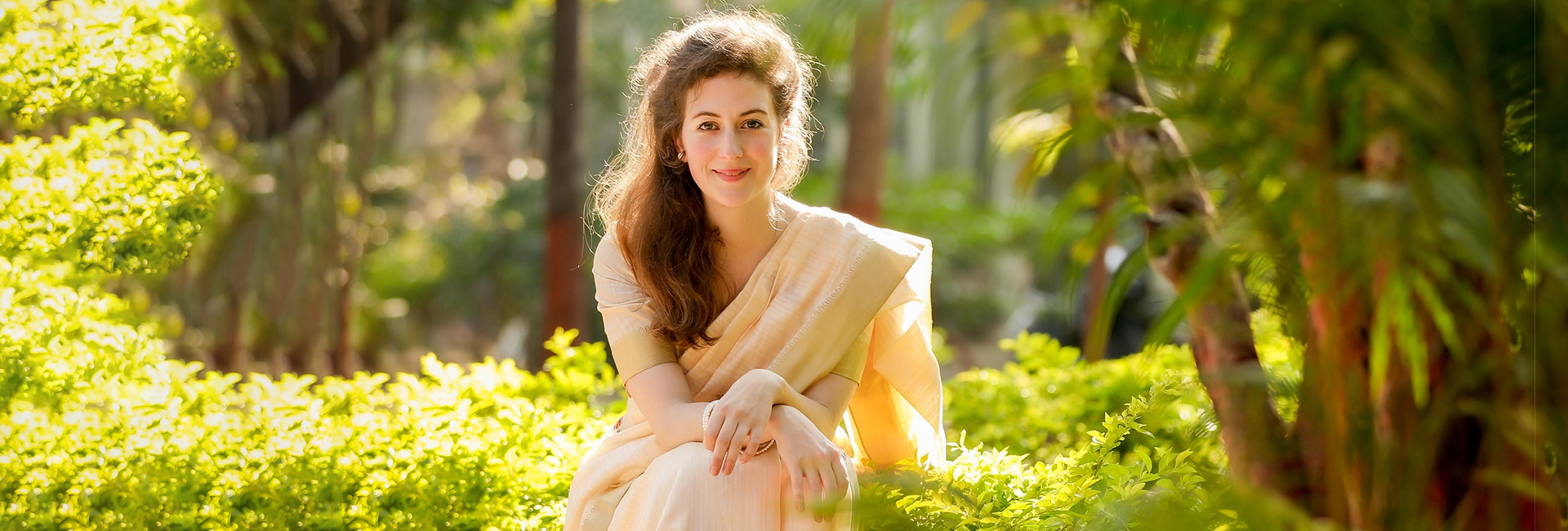(December 23, 2022) As a four-year-old growing up in London, Gabriella Burnell was introduced to Sanskrit by her parents. Having travelled to India as tourists, the couple had developed a deep appreciation for Indian culture and wanted their daughter to pick up the ancient divine language of the country. Starting with learning the language at St James School in London as a child, Gabriella went on to earn a degree in Sanskrit from Oxford University, pursuing it alongside music.
Today, she is a renowned performing artist whose music is steeped in Sanskrit verses. So immersed is she in the world of the divine language of India that Gabriella has even changed her name to Gaiea Sanskrit. ‘Gaiea’ in Sanskrit means ‘to be sung’, she says.

Gaiea Sanskrit
The artist performs at festivals, retreats and events, and conducts Sanskrit workshops and courses. She has also started Cosmic Choir, a Sanskrit singing group.
There is only one thing I have to do in this life, and that is to sing in Sanskrit.
“When I sing, there is no difference between me, what is being sung, and the singing itself.” It all becomes one and the same for Gaiea.
Deep love for the language and divinity of India
“My parents visited India several times, developing a deep appreciation for Indian traditions, culture and teachings, particularly Sanskrit,” Gaiea tells Global Indian.
“More than a language, it is a form of artistry for me. The sounds of the Sanskrit language have the capacity to awaken our souls,” the UK-based performing artist adds.
For her studying both Sanskrit and music from teachers in India and the UK is an ongoing journey. Visiting India as a pupil to learn Dhrupad is an annual affair for Gaiea. “One of my earliest gurus in India was Shri Shantananda Saraswati, Shankaracharya of the north, who was also my parents’ teacher,” she reveals. Over the years, many gurus left an indelible impact on Gaiea’s choice of life.
With the notion that the power of sound goes beyond borders, and is completely universal, she intends to be in service to music and Sanskrit for as long as she is guided by the ‘divine force’.
The culture in Sanskrit language is universal and that’s why it transcends boundaries.

“India has been custodian of Sanskrit. I feel like a child who has been assigned a duty to be dedicated to it so that I am able to become a master, one day” she remarks.
Spiritual bliss
“For my mum, spiritual well-being as well as access to culture and discipline was most important,” tells the singer.
After finishing her Bachelor’s, Gaiea went on to pursue Master’s in music theater, and later qualified as a teacher in Alexander Technique.
However, it was the spiritual world of Sanskrit verses that engulfed her interests. She loved being a Sanskrit scholar, and also loved performing music. “My artistic side married the scholastic side and became one,” she tells.

Gaiea Sanskrit with her mother
Talking about the deep concentration with which she performs on stage, Gaiea says, “It feels as if I am sculpting something. It’s different from practicing. When I am performing for an audience, something takes over. The same happens during chanting sessions and workshops that I conduct.”
For her performances are an act of letting go – of anything that she has been holding on to for the whole day and be free for that time frame. “All the other stuff disappears and literally there is no room in my whole body and mind for anything else,” she says.
Transforming lives
Gaiea enjoys a huge following on YouTube. While most of her subscribers are from India, she also caters to the audience from America, Spain, Germany, England and many other places across the world.
The feedback that the performing artist receives from her fans are testimony of how she has transformed their lives through music and divine Sanskrit chanting.
People of the Indian diaspora feel that something is there in my songs that calls them back home.
Gaiea is also a scholar of Upanishads. “One of them says that ‘what you know, teach,’ so even though I have a lot more to learn, I try to pass across whatever knowledge I have gathered so far to my pupils,” she mentions.
Popularity of Sanskrit in the western world
Gaiea believes that more people are interested in learning Sanskrit in western countries because of the popularity of yoga. “Yoga is everywhere and people are interested in knowing about its origin and that is how they come across Sanskrit and get interested in learning.”
However, for Gaiea ‘Sanskrit itself is music’ that emanates the vibrations of divine sounds. “It has the capacity to be super comic or super poetic, and is a language that taps into your core,” she remarks.
Also Read: Philippa Kaye: Advancing sustainable tourism through ‘Indian Experiences’





नमस्कार भगिनी, अहं भारतस्य केरलस्य एकः व्यक्तिः अस्मि यः भवतः बहु प्रशंसां करोमि, यद्यपि भवतः वचनं शृणोति, भवता यत् मदुराष्टकं गानीयं तत् श्रीकृष्णस्य विषये भक्तिगीतं अस्ति, मम भवतः वर्णनार्थं शब्दाः नास्ति। त्वं सर्वथा अतीव उत्तमः व्यक्तिः असि।